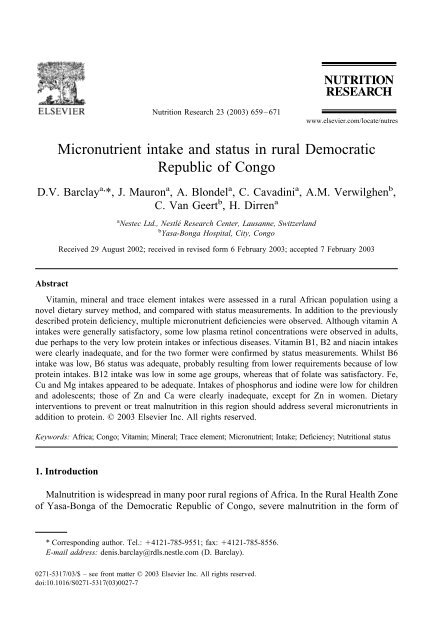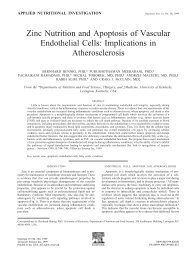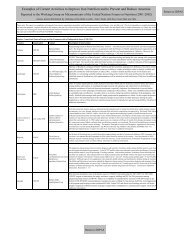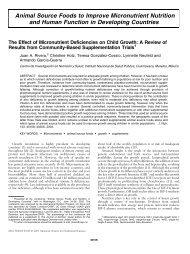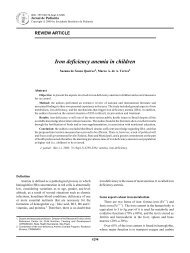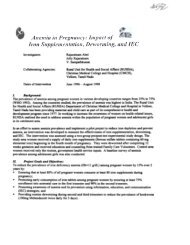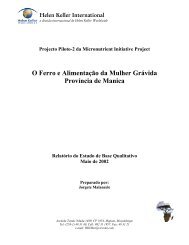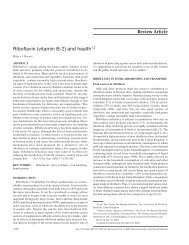Micronutrient intake and status in rural Democratic ... - ResearchGate
Micronutrient intake and status in rural Democratic ... - ResearchGate
Micronutrient intake and status in rural Democratic ... - ResearchGate
Create successful ePaper yourself
Turn your PDF publications into a flip-book with our unique Google optimized e-Paper software.
Nutrition Research 23 (2003) 659–671<br />
www.elsevier.com/locate/nutres<br />
<strong>Micronutrient</strong> <strong><strong>in</strong>take</strong> <strong>and</strong> <strong>status</strong> <strong>in</strong> <strong>rural</strong> <strong>Democratic</strong><br />
Republic of Congo<br />
D.V. Barclay a, *, J. Mauron a , A. Blondel a , C. Cavad<strong>in</strong>i a , A.M. Verwilghen b ,<br />
C. Van Geert b , H. Dirren a<br />
a Nestec Ltd., Nestlé Research Center, Lausanne, Switzerl<strong>and</strong><br />
b Yasa-Bonga Hospital, City, Congo<br />
Received 29 August 2002; received <strong>in</strong> revised form 6 February 2003; accepted 7 February 2003<br />
Abstract<br />
Vitam<strong>in</strong>, m<strong>in</strong>eral <strong>and</strong> trace element <strong><strong>in</strong>take</strong>s were assessed <strong>in</strong> a <strong>rural</strong> African population us<strong>in</strong>g a<br />
novel dietary survey method, <strong>and</strong> compared with <strong>status</strong> measurements. In addition to the previously<br />
described prote<strong>in</strong> deficiency, multiple micronutrient deficiencies were observed. Although vitam<strong>in</strong> A<br />
<strong><strong>in</strong>take</strong>s were generally satisfactory, some low plasma ret<strong>in</strong>ol concentrations were observed <strong>in</strong> adults,<br />
due perhaps to the very low prote<strong>in</strong> <strong><strong>in</strong>take</strong>s or <strong>in</strong>fectious diseases. Vitam<strong>in</strong> B1, B2 <strong>and</strong> niac<strong>in</strong> <strong><strong>in</strong>take</strong>s<br />
were clearly <strong>in</strong>adequate, <strong>and</strong> for the two former were confirmed by <strong>status</strong> measurements. Whilst B6<br />
<strong><strong>in</strong>take</strong> was low, B6 <strong>status</strong> was adequate, probably result<strong>in</strong>g from lower requirements because of low<br />
prote<strong>in</strong> <strong><strong>in</strong>take</strong>s. B12 <strong><strong>in</strong>take</strong> was low <strong>in</strong> some age groups, whereas that of folate was satisfactory. Fe,<br />
Cu <strong>and</strong> Mg <strong><strong>in</strong>take</strong>s appeared to be adequate. Intakes of phosphorus <strong>and</strong> iod<strong>in</strong>e were low for children<br />
<strong>and</strong> adolescents; those of Zn <strong>and</strong> Ca were clearly <strong>in</strong>adequate, except for Zn <strong>in</strong> women. Dietary<br />
<strong>in</strong>terventions to prevent or treat malnutrition <strong>in</strong> this region should address several micronutrients <strong>in</strong><br />
addition to prote<strong>in</strong>. © 2003 Elsevier Inc. All rights reserved.<br />
Keywords: Africa; Congo; Vitam<strong>in</strong>; M<strong>in</strong>eral; Trace element; <strong>Micronutrient</strong>; Intake; Deficiency; Nutritional <strong>status</strong><br />
1. Introduction<br />
Malnutrition is widespread <strong>in</strong> many poor <strong>rural</strong> regions of Africa. In the Rural Health Zone<br />
of Yasa-Bonga of the <strong>Democratic</strong> Republic of Congo, severe malnutrition <strong>in</strong> the form of<br />
* Correspond<strong>in</strong>g author. Tel.: 4121-785-9551; fax: 4121-785-8556.<br />
E-mail address: denis.barclay@rdls.nestle.com (D. Barclay).<br />
0271-5317/03/$ – see front matter © 2003 Elsevier Inc. All rights reserved.<br />
doi:10.1016/S0271-5317(03)0027-7
660 D.V. Barclay et al. / Nutrition Research 23 (2003) 659–671<br />
kwashiorkor or marasmic kwashiorkor is frequent <strong>and</strong> generally affects children <strong>and</strong> women<br />
of child-bear<strong>in</strong>g age [1,2]. In general, villagers <strong>in</strong> this region live from subsistence farm<strong>in</strong>g<br />
<strong>and</strong> food gather<strong>in</strong>g. Malnutrition <strong>in</strong>creases <strong>in</strong> the dry season from July to October when the<br />
food supply becomes scarce, up to the groundnut harvest beg<strong>in</strong>n<strong>in</strong>g <strong>in</strong> February. Maternal<br />
nutritional <strong>status</strong> was previously shown to strongly <strong>in</strong>fluence lactation <strong>and</strong> <strong>in</strong>fant growth <strong>in</strong><br />
these villages [3]. The most recent published data available showed that one-quarter of<br />
children under 5 years presented cl<strong>in</strong>ical signs of prote<strong>in</strong>-energy malnutrition <strong>and</strong> 40% had<br />
a weight-for-height less than the 5 th percentile of the WHO reference values [4]. Biochemical<br />
studies of malnutrition <strong>in</strong> this region have po<strong>in</strong>ted to dietary prote<strong>in</strong> <strong>in</strong>adequacy as be<strong>in</strong>g a<br />
major nutritional deficiency [5–7], confirmed by our study on macronutrient <strong><strong>in</strong>take</strong>s [8,9].<br />
Given the economic decl<strong>in</strong>e <strong>in</strong> the country s<strong>in</strong>ce these observations were made, the nutritional<br />
<strong>status</strong> of the <strong>rural</strong> population has certa<strong>in</strong>ly not improved, as witnessed by cont<strong>in</strong>ued<br />
admission of patients with various manifestations of malnutrition. S<strong>in</strong>ce no <strong>in</strong>formation on<br />
food <strong>and</strong> nutrient <strong><strong>in</strong>take</strong>s was available for this region, we carried out dietary surveys <strong>in</strong><br />
villages surround<strong>in</strong>g the hospital. In general, the villagers consume two meals daily, each<br />
compris<strong>in</strong>g a bulky cassava dough ball, sometimes with maize, <strong>and</strong> a spicy vegetable stew<br />
or sauce. The latter conta<strong>in</strong>s salt <strong>and</strong> hot red peppers, <strong>and</strong> one or more other <strong>in</strong>gredients such<br />
as cassava leaves or wild vegetables, mushrooms, groundnuts or melon seeds, palm oil, fish<br />
<strong>and</strong> extremely seldom, meat. We previously reported macronutrient <strong><strong>in</strong>take</strong>s [8,9] show<strong>in</strong>g<br />
that prote<strong>in</strong> <strong>and</strong> fat provided less than 5% <strong>and</strong> 10% respectively, of energy <strong><strong>in</strong>take</strong> across all<br />
age groups, ma<strong>in</strong>ly as a result of the very high <strong><strong>in</strong>take</strong> of cassava (Manihot esculenta). Indeed,<br />
cassava provided a mean of 82%, 27%, 12% <strong>and</strong> 92% respectively, of dietary energy,<br />
prote<strong>in</strong>, fat <strong>and</strong> carbohydrate. Thus the dietary pattern <strong>in</strong> this region, widespread <strong>in</strong> equatorial<br />
Africa, with overwhelm<strong>in</strong>g reliance on cassava as a source of energy, needs to be documented<br />
<strong>in</strong> order to better underst<strong>and</strong> the underly<strong>in</strong>g causes of malnutrition. We report here<br />
micronutrient <strong><strong>in</strong>take</strong>s <strong>and</strong> <strong>status</strong>.<br />
2. Subjects <strong>and</strong> methods<br />
2.1. Study location<br />
The study was conducted <strong>in</strong> the Rural Health Zone of Yasa-Bonga, some 450 km east of<br />
K<strong>in</strong>shasa, <strong>in</strong> the <strong>Democratic</strong> Republic of Congo. Surveys were carried out on five different<br />
occasions between 1981 <strong>and</strong> 1987 <strong>in</strong> five villages (Mikula, K<strong>in</strong>abamba, K<strong>in</strong>zamba-Kasai,<br />
Mbanza Muluma, Mbanza Ng<strong>and</strong>a) with<strong>in</strong> a 15 km radius of the Yasa-Bonga hospital.<br />
2.2. Subjects<br />
78 subjects from 12 families participated <strong>in</strong> the study, result<strong>in</strong>g <strong>in</strong> a total of 132 <strong>in</strong>dividual<br />
observations of 5 to 10 days each<br />
● 33 <strong>in</strong> children, 4-8 years (14 girls, 19 boys)<br />
● 15 <strong>in</strong> children, 9-13 years (8 girls, 7 boys)
D.V. Barclay et al. / Nutrition Research 23 (2003) 659–671<br />
661<br />
● 19 <strong>in</strong> adolescents, 14-18 years (7 girls, 12 boys)<br />
● 65 <strong>in</strong> adults, (34 women, 31 men)<br />
The study was approved by the Director of the Yasa-Bonga hospital. The subjects gave their<br />
<strong>in</strong>formed verbal consent after explanation of the goals <strong>and</strong> methods of the study.<br />
2.3. Dietary survey<br />
Given the meal habits <strong>in</strong> this region (consumption from family bowls; i.e. no <strong>in</strong>dividual<br />
portions), a novel dietary assessment method was employed. This method was previously<br />
described <strong>in</strong> detail [8,9]. Briefly, all subjects were weighed immediately before <strong>and</strong> after each<br />
of the two daily meals. Mechanical balances (precision of 50g; Sauter BN <strong>and</strong> LGK125P,<br />
August Sauter GmbH, Albstadt, Germany) were used, <strong>and</strong> weight ga<strong>in</strong>s dur<strong>in</strong>g meals were<br />
calculated by difference. The <strong>in</strong>dividual weight <strong>in</strong>crements allowed the calculation, for each<br />
subject, of food consumption as a percentage of the global family consumption.<br />
All foods consumed at the morn<strong>in</strong>g <strong>and</strong> even<strong>in</strong>g meals over 5-10 study days <strong>and</strong> left-overs<br />
were accurately weighed us<strong>in</strong>g a mechanical balance (precision of 1g; Terraillon SA,<br />
Annemasse, France). For each family, composite samples of all sauce <strong>in</strong>gredients (i.e. except<br />
cassava <strong>and</strong> maize staples) were frozen <strong>and</strong> shipped to the Nestlé Research Center <strong>in</strong><br />
Switzerl<strong>and</strong> where they were homogenized <strong>and</strong> freeze-dried <strong>and</strong> stored <strong>in</strong> Teflon-l<strong>in</strong>ed cans<br />
under nitrogen for analysis of vitam<strong>in</strong>s <strong>and</strong> m<strong>in</strong>erals. A total of 27 freeze-dried sauce samples<br />
were thus obta<strong>in</strong>ed, one per family per study period. Separate samples of cassava <strong>and</strong> maize<br />
were taken regularly for analysis <strong>and</strong> were treated as the sauce samples. One composite<br />
sample of cassava flour <strong>and</strong> one of maize flour, each one compris<strong>in</strong>g 10 <strong>in</strong>dividual flour<br />
samples, were then analyzed.<br />
2.4. Food analyses<br />
Aliquots of all samples were sent to the TNO, Zeist, The Netherl<strong>and</strong>s for analysis of<br />
vitam<strong>in</strong>s. Vitam<strong>in</strong> A <strong>and</strong> carotenoids were determ<strong>in</strong>ed by liquid chromatography [10].<br />
Vitam<strong>in</strong> A content was calculated as ret<strong>in</strong>ol equivalents (RE), us<strong>in</strong>g conversion factors of<br />
12ug for -carotene <strong>and</strong> 24g for other provitam<strong>in</strong> A carotenoids. Vitam<strong>in</strong>s B1 <strong>and</strong> B2 were<br />
determ<strong>in</strong>ed by liquid chromatography [11]. Vitam<strong>in</strong> B6, niac<strong>in</strong> <strong>and</strong> folate were measured<br />
us<strong>in</strong>g microbiological assays [12,13] <strong>and</strong> vitam<strong>in</strong> B12 us<strong>in</strong>g a competitive prote<strong>in</strong> b<strong>in</strong>d<strong>in</strong>g<br />
radioassay [14]. Ca, Cu, Fe, Mg <strong>and</strong> Zn were measured by atomic absorption spectrometry<br />
[15]. Phosphorus was determ<strong>in</strong>ed us<strong>in</strong>g the molybdenum blue colorimetric method [16], <strong>and</strong><br />
iod<strong>in</strong>e by gas chromatography [17].<br />
2.5. <strong>Micronutrient</strong> <strong><strong>in</strong>take</strong>s<br />
Individual vitam<strong>in</strong> <strong>and</strong> m<strong>in</strong>eral <strong><strong>in</strong>take</strong>s were calculated us<strong>in</strong>g global family food consumption,<br />
<strong>in</strong>dividual weight ga<strong>in</strong>s <strong>and</strong> the composition of the respective sauce, cassava <strong>and</strong><br />
maize samples. The adequacy of vitam<strong>in</strong> <strong>and</strong> m<strong>in</strong>eral <strong><strong>in</strong>take</strong>s were evaluated by comparison<br />
with the Dietary Reference Intakes (DRIs), 1997-2001 [18–20].
662 D.V. Barclay et al. / Nutrition Research 23 (2003) 659–671<br />
Table 1<br />
Subject description<br />
Age (years)<br />
Weight (kg)<br />
n range mean SD range mean SD<br />
Males 19 4–8 5.6 1.3 6.4–17.0 11.7 2.6<br />
7 9–13 11.3 1.6 12.2–25.0 18.2 4.6<br />
12 14–18 15.8 1.3 21.0–28.0 25.2 2.6<br />
31 19–66 39.8 14.3 28.0–54.5 44.9 6.0<br />
Females 14 4–8 6.6 1.3 10.4–16.5 13.5 1.8<br />
8 9–13 10.6 1.6 16.0–24.0 19.0 2.9<br />
7 14–17 14.9 1.2 22.0–30.0 25.6 2.8<br />
34 20–48 30.8 8.8 32.6–42.0 40.4 3.9<br />
2.6. <strong>Micronutrient</strong> <strong>status</strong><br />
Dur<strong>in</strong>g the dietary surveys, fast<strong>in</strong>g blood samples were drawn from adult subjects <strong>in</strong> order<br />
to measure nutritional <strong>status</strong> parameters with respect to certa<strong>in</strong> vitam<strong>in</strong>s <strong>and</strong> m<strong>in</strong>erals. Serum<br />
ret<strong>in</strong>ol was determ<strong>in</strong>ed by fluorimetry [21]. Thiam<strong>in</strong> <strong>status</strong> was assessed enzymatically by<br />
determ<strong>in</strong>ation of the activation coefficient of erythrocyte transketolase (ETK; [22]) <strong>and</strong><br />
riboflav<strong>in</strong> <strong>status</strong> by determ<strong>in</strong>ation of the activation coefficient of erythrocyte glutathione<br />
reductase (EGR; [23]). Vitam<strong>in</strong> B6 <strong>status</strong> was determ<strong>in</strong>ed accord<strong>in</strong>g to two different<br />
methods: the activation coefficient of erythrocyte aspartic transam<strong>in</strong>ase (EAST; [24]), <strong>and</strong><br />
plasma pyridoxal 5'-phosphate (PLP; [25]). Plasma vitam<strong>in</strong> C was determ<strong>in</strong>ed by microfluorimetry<br />
[26]. Blood hemoglob<strong>in</strong> levels were determ<strong>in</strong>ed us<strong>in</strong>g the cyanmethemoglob<strong>in</strong> method.<br />
<strong>Micronutrient</strong> <strong>status</strong> was def<strong>in</strong>ed as normal, low or deficient accord<strong>in</strong>g to commonly used cutoffs.<br />
3. Results<br />
3.1. Subject description<br />
The age (range, mean SD) <strong>and</strong> body weights (range, mean SD) of the subjects are<br />
given accord<strong>in</strong>g to gender <strong>and</strong> age group <strong>in</strong> Table 1.<br />
3.2. <strong>Micronutrient</strong> <strong><strong>in</strong>take</strong>s<br />
Daily <strong><strong>in</strong>take</strong>s of vitam<strong>in</strong>s, m<strong>in</strong>erals <strong>and</strong> trace elements by age <strong>and</strong> gender are presented <strong>in</strong><br />
Table 2 (mean SD), <strong>and</strong> <strong>in</strong> Figs. 1 <strong>and</strong> 2 as percentages of Dietary Reference Intakes<br />
[18–20]. Compared to DRIs, <strong><strong>in</strong>take</strong>s of vitam<strong>in</strong>s B1, B2, B6 <strong>and</strong> niac<strong>in</strong> were clearly low for<br />
all age groups; mean <strong><strong>in</strong>take</strong>s were generally less than 60% of DRIs. Intakes of vitam<strong>in</strong> B12<br />
were marg<strong>in</strong>ally low, whereas those of vitam<strong>in</strong> A <strong>and</strong> folate generally equaled or exceeded<br />
DRIs. For the m<strong>in</strong>erals <strong>and</strong> trace elements, dietary <strong><strong>in</strong>take</strong>s of Fe, Cu <strong>and</strong> Mg were generally<br />
satisfactory. Intakes of phosphorus <strong>and</strong> iod<strong>in</strong>e were low for children <strong>and</strong> adolescents only,<br />
whereas those of Zn <strong>and</strong> Ca were clearly <strong>in</strong>adequate for all age groups, with the exception<br />
of z<strong>in</strong>c <strong>in</strong> adult women.
Table 2<br />
Daily vitam<strong>in</strong> <strong>and</strong> m<strong>in</strong>eral <strong><strong>in</strong>take</strong>s (mean SD) by age group <strong>and</strong> sex<br />
M4-8 F4-8 M9-13 F9-13 M14-18 F14-18 M19 F19<br />
n 19 14 7 8 12 7 31 34<br />
Vitam<strong>in</strong> A gRE 489 293 363 213 840 332 613 284 726 418 703 280 987 459 1127 646<br />
Vitam<strong>in</strong> B1 mg 0.17 0.11 0.19 0.12 0.26 0.13 0.25 0.13 0.41 0.21 0.38 0.25 0.42 0.26 0.48 0.29<br />
Vitam<strong>in</strong> B2 mg 0.26 0.13 0.21 0.11 0.37 0.13 0.44 0.18 0.41 0.10 0.39 0.15 0.57 0.26 0.58 0.20<br />
Vitam<strong>in</strong> B6 mg 0.32 0.13 0.31 0.13 0.54 0.12 0.47 0.09 0.65 0.17 0.63 0.21 0.75 0.28 0.83 0.28<br />
Niac<strong>in</strong> mg 4.9 2.0 4.3 1.6 8.5 2.0 7.7 1.7 8.6 1.9 8.1 2.0 10.7 3.5 11.9 3.9<br />
Vitam<strong>in</strong> B12 g 1.00 0.69 0.94 0.53 1.45 0.76 1.75 0.78 1.81 0.73 1.25 0.86 2.15 1.12 2.48 1.48<br />
Folates g 224 81 196 110 304 86 303 68 353 115 404 130 465 186 536 214<br />
Iron mg 8.5 4.4 7.3 3.2 12.8 3.6 14.4 5.6 13.3 4.1 12.1 4.1 18.2 7.6 20.0 8.5<br />
Z<strong>in</strong>c mg 3.2 1.5 3.0 1.4 4.7 1.2 5.3 2.0 5.6 1.8 5.1 1.5 6.9 2.6 7.7 3.3<br />
Copper g 584 285 514 211 929 206 875 276 967 239 1000 408 1274 499 1415 532<br />
Calcium mg 222 129 240 111 333 171 410 150 459 191 323 178 533 225 615 296<br />
Magnesium mg 153 50 162 54 273 47 268 112 362 171 282 72 380 120 434 147<br />
Phosphorus mg 342 120 362 143 562 138 553 111 687 181 607 173 803 249 924 319<br />
Iod<strong>in</strong>e g 53 18 55 19 99 19 88 11 112 17 101 30 133 43 145 35<br />
D.V. Barclay et al. / Nutrition Research 23 (2003) 659–671<br />
663
664 D.V. Barclay et al. / Nutrition Research 23 (2003) 659–671<br />
Fig. 1. Mean daily vitam<strong>in</strong> <strong><strong>in</strong>take</strong>s, accord<strong>in</strong>g to age <strong>and</strong> gender, as percentages of Dietary Reference Intakes,<br />
1997–2001 [18–20].<br />
Fig. 2. Mean daily m<strong>in</strong>eral <strong>and</strong> trace element <strong><strong>in</strong>take</strong>s, accord<strong>in</strong>g to age <strong>and</strong> gender, as percentages of Dietary<br />
Reference Intakes, 1997-2001 [18–20].
D.V. Barclay et al. / Nutrition Research 23 (2003) 659–671<br />
665<br />
Fig. 3. Proportions of total micronutrient <strong><strong>in</strong>take</strong>s from staple foods <strong>and</strong> sauces.<br />
The contributions to micronutrient <strong><strong>in</strong>take</strong>s of the dietary staples cassava <strong>and</strong> maize, as well<br />
as the vegetable sauces, are given <strong>in</strong> Fig. 3. Almost 100% of vitam<strong>in</strong> A <strong><strong>in</strong>take</strong> came from the<br />
vegetable sauces. The sauces were also major contributors to vitam<strong>in</strong> B2, B12, folate, Ca <strong>and</strong><br />
Cu <strong><strong>in</strong>take</strong>s. For all other vitam<strong>in</strong>s <strong>and</strong> m<strong>in</strong>erals considered, large proportions (35-85%) of<br />
dietary <strong><strong>in</strong>take</strong>s were derived from cassava <strong>and</strong>, to a lesser extent, from maize.<br />
3.3. <strong>Micronutrient</strong> <strong>status</strong><br />
The biochemical <strong>in</strong>dicators of micronutrient <strong>status</strong> of adults are shown <strong>in</strong> Table 3. For<br />
vitam<strong>in</strong> A, 27% of plasma ret<strong>in</strong>ol values were low, <strong>and</strong> 3% were <strong>in</strong> the deficient range. For<br />
thiam<strong>in</strong> <strong>and</strong> riboflav<strong>in</strong> <strong>status</strong> <strong>in</strong>dicators, 38% <strong>and</strong> 25%, respectively, of values were low <strong>and</strong><br />
13% <strong>and</strong> 56%, respectively, <strong>in</strong>dicated deficiency. All values for both markers of vitam<strong>in</strong> B6<br />
<strong>status</strong> were <strong>in</strong> the normal ranges. For vitam<strong>in</strong> C, 15% of values were low, but none were <strong>in</strong><br />
the deficient range.<br />
4. Discussion<br />
Deficiencies <strong>in</strong> micronutrients are associated with <strong>in</strong>creased risks of morbidity <strong>and</strong><br />
mortality. For example, vitam<strong>in</strong> A deficiency is associated with <strong>in</strong>creased risk for xerophthalmia<br />
<strong>and</strong> bl<strong>in</strong>dness, severe <strong>in</strong>fection, anemia, poor growth <strong>and</strong> mortality [27]; iron<br />
deficiency dur<strong>in</strong>g <strong>in</strong>fancy impairs cognitive development <strong>and</strong> immune function <strong>and</strong> is<br />
associated with <strong>in</strong>creased morbidity [28]; iod<strong>in</strong>e deficiency dur<strong>in</strong>g pregnancy <strong>and</strong> childhood<br />
is the s<strong>in</strong>gle most important preventable cause of bra<strong>in</strong> damage worldwide [29]; z<strong>in</strong>c<br />
deficiency, even mild-to-moderate, <strong>in</strong>creases the risk of poor growth <strong>and</strong> development,
666 D.V. Barclay et al. / Nutrition Research 23 (2003) 659–671<br />
Table 3<br />
<strong>Micronutrient</strong> <strong>status</strong> of adults<br />
Nutrient Indicator unit n Mean SD Low Deficient *<br />
Vit. A Plasma ret<strong>in</strong>ol mol/L 37 1.05 0.54 27% 3%<br />
Vit. B1 ETK — 16 1.14 0.07 38% 13%<br />
Vit. B2 EGR — 16 1.36 0.23 25% 56%<br />
Vit. B6 EAST — 16 1.61 0.15 0% —<br />
Vit. B6 PLP nmol/L 16 80 17 0% —<br />
Vit. C Plasma Vit. C mol/L 27 37 13 15% 0%<br />
Fe Hb (Females) g/L 8 104 30 50% —<br />
Fe Hb (Males) g/L 8 127 27 25% —<br />
* Range of normal, low <strong>and</strong> deficient <strong>status</strong>:<br />
Plasma ret<strong>in</strong>ol: normal: 0.70; low: 0.35–0.75; deficient: 0.35 mol/L<br />
ETK: normal: 1.15; low: 1.15–1.25; deficient: 1.25<br />
EGR: normal: 1.20; low: 1.20–1.29; deficient: 1.29<br />
EAST: normal: 2.00<br />
Plasma PLP normal: 30 nmol/L<br />
Plasma Vit. C: normal: 23; low: 11.4–23; deficient: 11.4 mol/L<br />
Hb (Females):<br />
low: 120 g/L<br />
Hb (Males):<br />
low: 130 g/L<br />
reduced immune function, <strong>in</strong>creased <strong>in</strong>fectious diseases <strong>and</strong> mortality [30]. S<strong>in</strong>ce there was<br />
no published <strong>in</strong>formation on the nutritional <strong>status</strong> of this poor <strong>rural</strong> population, we conducted<br />
studies <strong>in</strong> order to assess micronutrient <strong><strong>in</strong>take</strong>s <strong>and</strong> <strong>status</strong>.<br />
Given the heavy reliance on cassava, the dietary patterns <strong>and</strong> eat<strong>in</strong>g habits of this typical<br />
<strong>rural</strong> equatorial African population, as well as the lack of knowledge of the composition of<br />
several commonly consumed local foods, a novel method of measurement of nutrient <strong><strong>in</strong>take</strong>s<br />
had to be developed. This was well accepted by the subjects <strong>and</strong> provided a relatively simple<br />
way of estimat<strong>in</strong>g food <strong>and</strong> nutrient <strong><strong>in</strong>take</strong>s. S<strong>in</strong>ce <strong>in</strong>dividual portions are not served, the<br />
actual proportions of sauces <strong>and</strong> staples consumed by family members cannot be measured<br />
on an <strong>in</strong>dividual basis with this method; i.e. the average proportions <strong>and</strong> compositions for the<br />
family had to be used for all family members.<br />
We previously reported macronutrient <strong><strong>in</strong>take</strong>s <strong>in</strong> typical villages of this equatorial region<br />
of Africa, characterized by a hot, humid climate, poor soil, <strong>and</strong> with cassava as the ma<strong>in</strong> crop<br />
of the subsistence farmers [8,9]. The dietary <strong><strong>in</strong>take</strong>s <strong>in</strong> this region provide sufficient energy<br />
for the adult, but not for child growth. The observed prote<strong>in</strong> <strong><strong>in</strong>take</strong>s are clearly <strong>in</strong>adequate<br />
for all age groups. This is <strong>in</strong> agreement with the documented high frequency of kwashiorkor<br />
<strong>and</strong> marasmic kwashiorkor <strong>in</strong> this population. In the present report, the <strong><strong>in</strong>take</strong>s of several<br />
micronutrients were <strong>in</strong>adequate <strong>in</strong> comparison with DRIs. The highest micronutrient <strong><strong>in</strong>take</strong>s<br />
were generally found for women followed by men, adolescents <strong>and</strong> children, reflect<strong>in</strong>g<br />
differences <strong>in</strong> overall food <strong>and</strong> energy <strong><strong>in</strong>take</strong>s.<br />
4.1. Vitam<strong>in</strong> A<br />
Nearly 100% of vitam<strong>in</strong> A <strong><strong>in</strong>take</strong> came from the vegetable sauces <strong>in</strong> the form of<br />
carotenoids, s<strong>in</strong>ce foods of animal orig<strong>in</strong> were very rarely consumed. A large proportion of<br />
these carotenoids was provided by red palm oil, commonly consumed <strong>in</strong> this region.
D.V. Barclay et al. / Nutrition Research 23 (2003) 659–671<br />
667<br />
Compared to DRIs, vitam<strong>in</strong> A <strong><strong>in</strong>take</strong>s appeared to be generally satisfactory (Fig. 1).<br />
However plasma ret<strong>in</strong>ol levels showed quite wide variation between <strong>in</strong>dividuals, with<br />
approximately 27% <strong>and</strong> 3% respectively, of adult values <strong>in</strong> the low <strong>and</strong> deficient ranges.<br />
There are a number of possible explanations for this apparent contradiction. Firstly, the low<br />
prote<strong>in</strong> <strong>and</strong> lipid <strong><strong>in</strong>take</strong>s <strong>and</strong> deficiencies <strong>in</strong> other micronutrients may also <strong>in</strong>fluence vitam<strong>in</strong><br />
A nutrition <strong>in</strong> our subjects. Carotenoid cleavage <strong>and</strong> synthesis of ret<strong>in</strong>ol transport prote<strong>in</strong>s<br />
are reduced <strong>in</strong> prote<strong>in</strong> deficiency, <strong>and</strong> dietary fat is necessary for efficient <strong>in</strong>test<strong>in</strong>al absorption<br />
of vitam<strong>in</strong> A <strong>and</strong> carotenoids [31]. In contrast however, vitam<strong>in</strong> A <strong>status</strong> was normal <strong>in</strong><br />
malnourished Nigerian children consum<strong>in</strong>g considerable amounts of provitam<strong>in</strong> A carotenoids<br />
[32]. Another factor potentially <strong>in</strong>fluenc<strong>in</strong>g vitam<strong>in</strong> A <strong>status</strong> is malaria which is<br />
endemic <strong>in</strong> this part of Africa. In a neighbor<strong>in</strong>g region of the Congo, low serum ret<strong>in</strong>ol levels<br />
were observed <strong>in</strong> children suffer<strong>in</strong>g from malaria [33,34].<br />
4.2. B vitam<strong>in</strong>s<br />
Mean <strong><strong>in</strong>take</strong>s of vitam<strong>in</strong>s B1, B2, B6 <strong>and</strong> niac<strong>in</strong> were generally below 60% of DRIs, <strong>and</strong><br />
result from the absence of gra<strong>in</strong> products, meat <strong>and</strong> dairy foods <strong>in</strong> the diet. Intakes of vitam<strong>in</strong><br />
B12 were marg<strong>in</strong>ally low; those of folate were generally satisfactory. The limited thiam<strong>in</strong><br />
<strong>and</strong> riboflav<strong>in</strong> <strong>status</strong> data we report here tend to confirm the observed low <strong><strong>in</strong>take</strong> data.<br />
Beri-beri, although <strong>in</strong>frequent, is regularly observed <strong>in</strong> the region as documented by hospital<br />
admissions, confirm<strong>in</strong>g to a certa<strong>in</strong> degree the thiam<strong>in</strong> <strong><strong>in</strong>take</strong> <strong>and</strong> <strong>status</strong> data. Cl<strong>in</strong>ical signs<br />
of niac<strong>in</strong> deficiency have not been documented <strong>in</strong> the region surround<strong>in</strong>g the hospital.<br />
However, outbreaks of pellagra were observed further to the east near Lubumbashi <strong>and</strong><br />
responded rapidly to adm<strong>in</strong>istration of niac<strong>in</strong> [35]. For vitam<strong>in</strong> B6, our <strong>status</strong> data are not <strong>in</strong><br />
agreement with those on <strong><strong>in</strong>take</strong>. Despite some uncerta<strong>in</strong>ties <strong>and</strong> limitations of the methods<br />
employed for <strong>status</strong> measurement, we can tentatively conclude that the vitam<strong>in</strong> B6 <strong>status</strong> of<br />
these subjects was satisfactory <strong>in</strong> contrast to <strong><strong>in</strong>take</strong> which was clearly low (50-60%)<br />
compared to DRIs. The most obvious explanation for this is that pyridox<strong>in</strong>e requirements are<br />
related to prote<strong>in</strong> <strong><strong>in</strong>take</strong>, <strong>and</strong> may be expressed as 0.016 mg/g of prote<strong>in</strong> [36]. Consider<strong>in</strong>g<br />
the average prote<strong>in</strong> <strong><strong>in</strong>take</strong>s we previously measured <strong>in</strong> this population of 23 g/day (men <strong>and</strong><br />
women comb<strong>in</strong>ed), the vitam<strong>in</strong> B6 requirement for an adult would amount to 0.37 mg/day,<br />
a figure well covered by the measured average <strong><strong>in</strong>take</strong> of 0.8 mg/day.<br />
4.3. Iron<br />
Fe <strong><strong>in</strong>take</strong>s appeared to be generally sufficient; mean <strong><strong>in</strong>take</strong>s ranged from 73% <strong>in</strong> young<br />
girls to 110% <strong>in</strong> women <strong>and</strong> 230% <strong>in</strong> men compared to DRIs. However, we may have<br />
over-estimated the adequacy of the dietary Fe <strong><strong>in</strong>take</strong>, given that the quasi-totality of Fe was<br />
derived from plant sources <strong>and</strong> that animal prote<strong>in</strong> was virtually absent from the diet.<br />
Vitam<strong>in</strong> C is known to enhance food Fe bioavailability. Although we were unable to<br />
determ<strong>in</strong>e vitam<strong>in</strong> C <strong><strong>in</strong>take</strong> directly, nutritional <strong>status</strong> with respect to vitam<strong>in</strong> C was<br />
generally satisfactory suggest<strong>in</strong>g that <strong><strong>in</strong>take</strong>s were also satisfactory. We have no direct<br />
<strong>in</strong>formation on the level of phytic acid, a potent <strong>in</strong>hibitor of Fe absorption, <strong>in</strong> the diet of our<br />
subjects. However, the technique of steep<strong>in</strong>g peeled tubers <strong>in</strong> runn<strong>in</strong>g water for several days
668 D.V. Barclay et al. / Nutrition Research 23 (2003) 659–671<br />
prior to sun-dry<strong>in</strong>g <strong>and</strong> cook<strong>in</strong>g, as carried out by our subjects, has been shown to almost<br />
completely destroy the phytic acid <strong>in</strong> cassava [37]. Therefore, our data seem to <strong>in</strong>dicate that<br />
both the amount <strong>and</strong> bioavailability of dietary Fe may be adequate, or at least marg<strong>in</strong>ally so.<br />
Our very limited data on Fe <strong>status</strong> of our subjects do not allow us to draw firm conclusions<br />
on Fe nutrition <strong>in</strong> this region. Nevertheless, the high frequency of hookworm <strong>in</strong>festations <strong>and</strong><br />
the endemic malaria may well contribute more to the frequently observed anemia, than do<br />
<strong><strong>in</strong>take</strong> <strong>and</strong> bioavailability of dietary Fe. Although hospital records on anemia may not reflect<br />
population prevalences, those from the Yasa-Bonga hospital suggest that anemia is the most<br />
common micronutrient deficiency-related disorder <strong>in</strong> the region, the highest prevalences<br />
be<strong>in</strong>g <strong>in</strong> women <strong>and</strong> children. This lends support to the notion that adequate dietary Fe<br />
<strong><strong>in</strong>take</strong>s do not prevent a high prevalence of anemia under these particular circumstances with<br />
high rates of <strong>in</strong>fections <strong>and</strong> prote<strong>in</strong>-energy malnutrition. For comparison, <strong>in</strong> urban areas of<br />
the country (K<strong>in</strong>shasa), Fe deficiency affected more than 50% of mothers [38], <strong>and</strong> studies<br />
further to the east <strong>in</strong>dicated that anemia was related to prote<strong>in</strong>-energy malnutrition, perhaps<br />
mediated by selenium deficiency [39].<br />
4.4. Z<strong>in</strong>c <strong>and</strong> copper<br />
Compared to DRIs, Zn <strong><strong>in</strong>take</strong>s appeared to be very low across all age groups, except for<br />
adult women. However, <strong>in</strong> evaluat<strong>in</strong>g the adequacy of Zn <strong><strong>in</strong>take</strong>, we have to relate them to<br />
very low prote<strong>in</strong> <strong><strong>in</strong>take</strong>s <strong>in</strong> our subjects. Indeed, balance studies <strong>in</strong> adult men showed that Zn<br />
requirements were related <strong>in</strong> part to dietary phosphorus <strong>and</strong> prote<strong>in</strong> [40]. The requirement for<br />
Zn is lowest when dietary phosphorus <strong>and</strong> prote<strong>in</strong> are low, <strong>and</strong> highest when dietary<br />
phosphorus <strong>and</strong> prote<strong>in</strong> are high. S<strong>in</strong>ce the prote<strong>in</strong> <strong>and</strong> phosphorus <strong><strong>in</strong>take</strong>s of our subjects<br />
were low, the observed mean Zn <strong><strong>in</strong>take</strong>s of 7 to 8 mg/day <strong>in</strong> adults may not be as <strong>in</strong>adequate<br />
for men as they appear to be with respect with DRIs, whereas they are adequate for women. In<br />
comparison however, the Zn <strong>status</strong> of women <strong>in</strong> K<strong>in</strong>shasa was poor [41]. For the younger age<br />
groups, Zn <strong><strong>in</strong>take</strong>s were only 50-60% of DRIs, <strong>and</strong> may contribute to the high prevalence of<br />
stunt<strong>in</strong>g reported <strong>in</strong> the region [4]. Intakes of Cu appeared to be satisfactory across all age groups.<br />
4.5. Calcium<br />
Ca <strong><strong>in</strong>take</strong>s were uniformly low <strong>and</strong> consistent with the total absence of dairy products <strong>in</strong><br />
the diet. However, the apparently huge Ca deficit, especially <strong>in</strong> the younger age groups, may<br />
not be as big as it seems for a number of reasons. At low Ca <strong><strong>in</strong>take</strong>s, <strong>in</strong>test<strong>in</strong>al absorption<br />
is <strong>in</strong>creased <strong>and</strong> renal excretion is decreased. Moreover, Ca excretion <strong>in</strong> young adult men is<br />
dim<strong>in</strong>ished when prote<strong>in</strong> <strong><strong>in</strong>take</strong> is low <strong>and</strong> <strong>in</strong>creased when phosphorus <strong><strong>in</strong>take</strong> is low [42].<br />
Increased prote<strong>in</strong> <strong><strong>in</strong>take</strong> caused Ca balance to change from positive to negative at lower<br />
phosphorus <strong><strong>in</strong>take</strong>, but had no net effect at higher phosphorus <strong><strong>in</strong>take</strong>; i.e. the effect of prote<strong>in</strong><br />
is most pronounced at low phosphorus <strong><strong>in</strong>take</strong>s, which is the case for our subjects. It could<br />
therefore be argued that the observed Ca <strong><strong>in</strong>take</strong>s of our subjects may <strong>in</strong> fact only be<br />
marg<strong>in</strong>ally low. On the other h<strong>and</strong>, the low breast milk Ca levels previously described<br />
provide <strong>in</strong>direct evidence of <strong>in</strong>adequate Ca nutrition <strong>in</strong> this region [43]. Although not<br />
specifically described <strong>in</strong> the Congo, Ca-deficiency rickets has been shown to occur <strong>in</strong> South
D.V. Barclay et al. / Nutrition Research 23 (2003) 659–671<br />
669<br />
Africa <strong>and</strong> Nigeria [44,45]. Moreover, twelve months Ca supplementation of Gambian<br />
children with low habitual Ca <strong><strong>in</strong>take</strong>s significantly <strong>in</strong>creased bone m<strong>in</strong>eral accretion [46]. In<br />
contrast to these observations, the prevalence of rickets is very low <strong>in</strong> the Yasa-Bonga region<br />
as documented by extremely low hospital admission rates, thus lend<strong>in</strong>g support to the notion<br />
that under the local conditions, Ca <strong><strong>in</strong>take</strong> may <strong>in</strong> fact be only marg<strong>in</strong>ally <strong>in</strong>adequate.<br />
Compared to DRIs, <strong><strong>in</strong>take</strong>s of phosphorus were low <strong>in</strong> the younger age groups but not <strong>in</strong><br />
adults.<br />
4.6. Iod<strong>in</strong>e<br />
Iod<strong>in</strong>e <strong><strong>in</strong>take</strong>s were moderately low, especially <strong>in</strong> younger age groups. Furthermore, the<br />
very high consumption of cassava, potentially conta<strong>in</strong><strong>in</strong>g goitrogenic substances, may<br />
<strong>in</strong>crease the risk of iod<strong>in</strong>e deficiency as already shown elsewhere <strong>in</strong> the region [47]. However<br />
the villagers we observed steep the peeled cassava tubers for several days <strong>in</strong> runn<strong>in</strong>g water<br />
<strong>in</strong> order to remove cyanogenic glucosides. In spite of the <strong>in</strong>adequate prote<strong>in</strong> <strong><strong>in</strong>take</strong> which<br />
may aggravate the development of goiter as previously shown <strong>in</strong> Senegal [48], the hospital<br />
admission rate for goiter is low. This would suggest that the elim<strong>in</strong>ation of goitrogenic<br />
factors <strong>in</strong> cassava is performed efficiently by the villagers.<br />
In this poor <strong>rural</strong> region of equatorial Africa with cassava as the ma<strong>in</strong> staple food, dietary<br />
<strong>in</strong>terventions to prevent or treat malnutrition should pay special attention to several vitam<strong>in</strong>s<br />
<strong>and</strong> m<strong>in</strong>erals <strong>in</strong> addition to prote<strong>in</strong>. In contrast to most develop<strong>in</strong>g countries, it is more the<br />
low <strong><strong>in</strong>take</strong>s of vitam<strong>in</strong>s B1, B2, Ca <strong>and</strong> Zn rather than those of Fe, vitam<strong>in</strong> A <strong>and</strong> iod<strong>in</strong>e that<br />
appear to be most critical. S<strong>in</strong>ce salt is the only food item which is regularly purchased, it<br />
may constitute a vehicle for vitam<strong>in</strong> <strong>and</strong> m<strong>in</strong>eral fortification. However, given the absence<br />
of centralized salt production <strong>and</strong> the current socio-economic situation <strong>in</strong> the region, this may<br />
be impractical at present. An alternative approach could be the distribution of multimicronutrient<br />
supplements. S<strong>in</strong>ce prote<strong>in</strong> deficiency is also a major problem <strong>in</strong> this region,<br />
a more relevant approach might be the diversification of agricultural practices to <strong>in</strong>crease the<br />
production of legum<strong>in</strong>ous seeds (Bambara groundnuts, groundnuts, beans) <strong>and</strong> gra<strong>in</strong>s<br />
(maize, millet) <strong>in</strong> order to complement the high energy yield<strong>in</strong>g cassava. In addition to<br />
<strong>in</strong>creased prote<strong>in</strong> supply, such measures should also enable <strong>in</strong>creases <strong>in</strong> the supply of several<br />
micronutrients. It should be borne <strong>in</strong> m<strong>in</strong>d however that <strong>in</strong>creas<strong>in</strong>g prote<strong>in</strong> <strong><strong>in</strong>take</strong>s might<br />
simultaneously <strong>in</strong>crease the requirements for certa<strong>in</strong> micronutrients (vitam<strong>in</strong> B6, Zn, Ca).<br />
Acknowledgments<br />
All authors took part <strong>in</strong> the preparation <strong>and</strong> edit<strong>in</strong>g of this article. The collaboration of the<br />
late Mr. Marc Mboma over several years was greatly appreciated. We wish to thank nurses<br />
Paul<strong>in</strong>e (Kompany Sona) <strong>and</strong> Michou (Michel<strong>in</strong>e Ngay Ngay) <strong>and</strong> Mr. Dom<strong>in</strong>ique Tornare<br />
for their assistance dur<strong>in</strong>g the dietary surveys, Mr. Yvon Mangunza for laboratory analyses<br />
<strong>and</strong> Mr. Muhoza Dusabeyesu for transportation of samples <strong>and</strong> material. We would also like<br />
to express our appreciation to the subjects for their participation <strong>in</strong> the study. The study was<br />
supported by the Nestlé Research Center, Switzerl<strong>and</strong>.
670 D.V. Barclay et al. / Nutrition Research 23 (2003) 659–671<br />
References<br />
[1] Verwilghen AM. Contribution à l’étude de l’ulcère gastro-duodénal au Kwango. Ann Soc Belge Méd Trop<br />
1957;37:757–72.<br />
[2] Mauron J, Antener I. Is the adult prote<strong>in</strong>-energy malnutrition syndrome the same as that described <strong>in</strong> the<br />
<strong>in</strong>fant? In: Mauron J, editor. Nutritional adequacy, nutrient availability <strong>and</strong> needs. Basel: Birkhäuser Verlag,<br />
1983. 298–338.<br />
[3] Barclay DV. Influence of maternal nutritional <strong>status</strong> on lactational performance <strong>and</strong> child growth <strong>in</strong> <strong>rural</strong><br />
Zaire. Thesis. 1988. Université de Nancy 1, France.<br />
[4] Mudosa LK. Le diagnostic de la communauté dans l’évaluation des beso<strong>in</strong>s sanitaires est des priorités<br />
d’action d’une population en zone <strong>rural</strong>e (Zaïre). Thesis. 1984. Université Libre de Bruxelles.<br />
[5] Antener I, Verwilghen AM, Van Geert C, Mauron J. Biochemical study of malnutrition - situation before<br />
treatment. Acta Trop 1977;34:331–54.<br />
[6] Antener I, Verwilghen AM, Van Geert C, Mauron J. Dietary treatment of malnutrition. II. Balance sheets<br />
of the ma<strong>in</strong> nutrients. Internat J Vit Nutr Res 1977;47:167–99.<br />
[7] Antener I, Verwilghen AM, Van Geert C, Mauron J. Study on malnutrition. III. Biochemical assessment of<br />
the dietary treatment <strong>and</strong> evolution of the illness. Helv Paediatr Acta 1978;33:543–62.<br />
[8] Barclay D, Mauron J, Blondel A, Verwilghen AM, Van Geert C, Dirren H. Dietary <strong><strong>in</strong>take</strong> measurement <strong>in</strong><br />
<strong>rural</strong> Zaïre: Macronutrients. Nutr Res 1993;13:523–34.<br />
[9] Mauron J, Barclay D, Blondel A, Cavad<strong>in</strong>i C, Dirren H. Macronutrient <strong><strong>in</strong>take</strong> <strong>in</strong> <strong>rural</strong> Zaïre: measurement<br />
by an alternative direct weigh<strong>in</strong>g technique <strong>and</strong> food analysis. Bibl Nutr Dieta 1994;51:26–33.<br />
[10] Speek AJ, Temalilwa CR, Schrijver J. Determ<strong>in</strong>ation of -carotene <strong>and</strong> vitam<strong>in</strong> A activity of vegetables by<br />
high-performance liquid chromatrography <strong>and</strong> spectrophotometry. Food Chem 1986;19:65–74.<br />
[11] Van der Weerdhof T, Wiersum ML, Reissenweber H. Application of liquid chromatography <strong>in</strong> food<br />
analysis. J Chromatogr 1973;83:355–60.<br />
[12] Difco Laboratories. Dehydrated culture media <strong>and</strong> reagents for microbiology, 10th edition. Detroit, Michigan,<br />
USA: Difco Laboratories, 1984.<br />
[13] Williams S. Microbiological assays. In: Official Methods of Analysis of the Association of Official<br />
Analytical Chemists, 14th edition. Arl<strong>in</strong>gton, Virg<strong>in</strong>ia, USA: AOAC Inc, 1984. 862–873.<br />
[14] Van den Berg H, Br<strong>and</strong>sen L, S<strong>in</strong>keldam BJ. Vitam<strong>in</strong> B-12 content <strong>and</strong> bioavailability of spirul<strong>in</strong>a <strong>and</strong> nori<br />
<strong>in</strong> rats. J Nutr Biochem 1991;2:313–8.<br />
[15] Official Methods of Analysis of the Association of Official Analytical Chemists. 14 th edition, 1984. Atomic<br />
absorption spectrophotometry analysis dry ash<strong>in</strong>g sample preparation.<br />
[16] International Dairy Federation. Determ<strong>in</strong>ation of total phosphorus content. International IDF St<strong>and</strong>ard<br />
33C:1987.<br />
[17] Stijve T. Rapid gas chromatographic method for determ<strong>in</strong>ation of <strong>in</strong>organic iod<strong>in</strong>e <strong>in</strong> milk products <strong>and</strong><br />
dietetic foods. Deutsche Lebensmittel Rundschau 1988;84:341–4.<br />
[18] Institute of Medic<strong>in</strong>e. Dietary reference <strong><strong>in</strong>take</strong>s for calcium, phosphorus, magnesium, vitam<strong>in</strong> D, <strong>and</strong><br />
fluoride. Wash<strong>in</strong>gton DC: National Academy Press, 1997.<br />
[19] Institute of Medic<strong>in</strong>e. Dietary reference <strong><strong>in</strong>take</strong>s for thiam<strong>in</strong>, riboflav<strong>in</strong>, niac<strong>in</strong>, vitam<strong>in</strong> B6, folate, vitam<strong>in</strong><br />
B12, pantothenic acid, biot<strong>in</strong>, <strong>and</strong> chol<strong>in</strong>e. Wash<strong>in</strong>gton DC: National Academy Press, 1998.<br />
[20] Institute of Medic<strong>in</strong>e. Dietary reference <strong><strong>in</strong>take</strong>s for vitam<strong>in</strong> A, vitam<strong>in</strong> K, arsenic, boron, chromium, copper,<br />
iod<strong>in</strong>e, iron, manganese, molybdenum, nickel, silicon, vanadium, <strong>and</strong> z<strong>in</strong>c. Wash<strong>in</strong>gton DC: National<br />
Academy Press, 2001.<br />
[21] Kahan J. Automated fluorometric assay of serum vitam<strong>in</strong> A. Int J Vitam Nutr Res 1973;43:127–41.<br />
[22] Schouten H, van Eps LW, Struyker Boudier AM. Transketolase <strong>in</strong> blood. Cl<strong>in</strong> Chim Acta 1964;10:474–6.<br />
[23] Glatzle D, Korner WF, Christeller S, Wiss O. Method for the detection of a biochemical riboflav<strong>in</strong><br />
deficiency. Int Z Vitam<strong>in</strong>forsch 1970;40:166–83.<br />
[24] Raica N, Sauberlich HE. Blood cell transam<strong>in</strong>ase activity <strong>in</strong> human vitam<strong>in</strong> B6 deficiency. Am J Cl<strong>in</strong> Nutr<br />
1964;15:67–72.<br />
[25] Re<strong>in</strong>ken L, Mangold B. Pyridoxal phosphate values <strong>in</strong> premature <strong>in</strong>fants. Int J Vitam Res 1973;43:472–8.
D.V. Barclay et al. / Nutrition Research 23 (2003) 659–671<br />
671<br />
[26] Deutsch MJ, Weeks CE. Microfluorimetric assay for vitam<strong>in</strong> C. JAOAC 1965;48:1248–56.<br />
[27] WHO. Indicators for assess<strong>in</strong>g vitam<strong>in</strong> A deficiency <strong>and</strong> their application <strong>in</strong> monitor<strong>in</strong>g <strong>and</strong> evaluat<strong>in</strong>g<br />
<strong>in</strong>tervention programmes. Geneva: World Health Organization, 1996, WHO/NUT/96.10.<br />
[28] WHO, UNICEF, UNU. Iron deficiency anemia: assessment, prevention <strong>and</strong> control. Geneva: World Health<br />
Organization, 2001, WHO/NHD/01.3.<br />
[29] WHO, UNICEF, ICCIDD. Assessment of iod<strong>in</strong>e deficiency disorders <strong>and</strong> monitor<strong>in</strong>g their elim<strong>in</strong>ation. 2nd<br />
edition. Geneva: World Health Organization, 2001, WHO/NHD/01.1.<br />
[30] Black RE. Consequences of z<strong>in</strong>c deficiency on human health <strong>and</strong> alternatives for programmatic <strong>in</strong>tervention.<br />
In: Black RE, Michaelsen KF, editors. Public health issues <strong>in</strong> <strong>in</strong>fant <strong>and</strong> child nutrition. Philadelphia:<br />
Lipp<strong>in</strong>cott Williams <strong>and</strong> Wilk<strong>in</strong>s, 2002. p. 97–110.<br />
[31] Olson JA. Vitam<strong>in</strong> A. In: Machl<strong>in</strong> LJ, editor. H<strong>and</strong>book of vitam<strong>in</strong>s. 2nd edition. New York: Marcel<br />
Dekker, 1990. p. 1–57.<br />
[32] Adelekan DA, Fatusi AO, Fakunle JB, Olotu CT, Olukoga IA, J<strong>in</strong>adu MK, Ojofeitimi EO. Prevalence of<br />
malnutrition <strong>and</strong> vitam<strong>in</strong> A deficiency <strong>in</strong> Nigerian preschool children subsist<strong>in</strong>g on high <strong><strong>in</strong>take</strong>s of<br />
carotenes. Nutr Health 1997;12:17–24.<br />
[33] Samba C, Galan P, Luzeau R, Amedee-Manesme O. Vitam<strong>in</strong> A deficiency <strong>in</strong> pre-school age Congolese<br />
children dur<strong>in</strong>g malarial attacks. Part 1: Utilisation of impression cytology with transfer <strong>in</strong> an equatorial<br />
country. Internat J Vit Nutr Res 1990;60:215–23.<br />
[34] Galan P, Samba C, Luzeau R, Amedee-Manesme O. Vitam<strong>in</strong> A deficiency <strong>in</strong> pre-school age Congolese<br />
children dur<strong>in</strong>g malarial attacks. Part 2: Impact of parasitic disease on vitam<strong>in</strong> A <strong>status</strong>. Internat J Vit Nutr<br />
Res 1990;60:224–8.<br />
[35] Ermolieff S, Grosshans E. La Pellagre. Ann Dermatol Venereol (Paris) 1979;106:591–5.<br />
[36] Leklem JE. Vitam<strong>in</strong> B6. In: Machl<strong>in</strong> LJ, editor. H<strong>and</strong>book of vitam<strong>in</strong>s. 2nd edition. New York: Marcel<br />
Dekker, 1990. p. 341–392.<br />
[37] Joseph A. Influence de la technologie traditionnelle du manioc sur les teneurs en éléments m<strong>in</strong>éraux et en<br />
phosphore phytique (Influence of traditional process<strong>in</strong>g of cassava on m<strong>in</strong>eral <strong>and</strong> phytate phosphorus<br />
content). Ann Nutr Alim 1973;27:125–39.<br />
[38] Mashako L, Preziosi P, Nsibu C, Galan P, Poitier-de-Courcy G, Nsaka T, Hercberg S. Iron <strong>and</strong> folate <strong>status</strong><br />
<strong>in</strong> Zairian mothers <strong>and</strong> their newborns. Ann Nutr Metab 1991;35:309–14.<br />
[39] Fondu P, Hariga-Muller C, Mozes N, Neve J, Van Steirteghem A, M<strong>and</strong>elbaum IM. Prote<strong>in</strong>-energy<br />
malnutrition <strong>and</strong> anemia <strong>in</strong> Kivu. Am J Cl<strong>in</strong> Nutr 1978;31:46–56.<br />
[40] Mahalko JR, S<strong>and</strong>stead HH, Johnson LK, Milne DB. Effect of a moderate <strong>in</strong>crease <strong>in</strong> dietary prote<strong>in</strong> on the<br />
retention <strong>and</strong> excretion of Ca, Cu, Fe, Mg, P, <strong>and</strong> Zn by adult males. Am J Cl<strong>in</strong> Nutr 1983;37:8–14.<br />
[41] Arnaud J, Preziosi P, Mashako L, Galan P, Nsibu C, Favier A, Kapongo C, Hercberg S. Serum trace<br />
elements <strong>in</strong> Zairian mothers <strong>and</strong> their newborns. Eur J Cl<strong>in</strong> Nutr 1993;48:341–8.<br />
[42] Hegsted M, Schuette SA, Zemel MB, L<strong>in</strong>kswiler HM. Ur<strong>in</strong>ary calcium <strong>and</strong> calcium balance <strong>in</strong> young men<br />
as affected by level of prote<strong>in</strong> <strong>and</strong> phosphorus <strong><strong>in</strong>take</strong>. J Nutr 1981;111:553–62.<br />
[43] Prentice A, Barclay DV. Breast-milk calcium <strong>and</strong> phosphorus concentrations of mothers <strong>in</strong> <strong>rural</strong> Zaire. Eur<br />
J Cl<strong>in</strong> Nutr 1991;45:611–7.<br />
[44] Pettifor JM, Ross P, Wang J, Moodley G, Couper-Smith J. Rickets <strong>in</strong> children of <strong>rural</strong> orig<strong>in</strong> <strong>in</strong> South<br />
Africa: is low dietary calcium a factor? J Pediatr 1978;92:320–4.<br />
[45] Thacher TD, Fischer PR, Pettifor JM, Lawson JO, Isichei CO, Read<strong>in</strong>g JC, Chan GM. A comparison of<br />
calcium, vitam<strong>in</strong> D, or both for nutritional rickets <strong>in</strong> Nigerian children. N Engl J Med 1999;341:563–8.<br />
[46] Dibba B, Prentice A, Ceesay M, Stirl<strong>in</strong>g DM, Cole TJ, Poskitt EM. Effect of calcium supplementation on<br />
bone m<strong>in</strong>eral accretion <strong>in</strong> gambian children accustomed to a low-calcium diet. Am J Cl<strong>in</strong> Nutr 2000;71:<br />
544–9.<br />
[47] Delange F, Ermans AM. Role of a dietary goitrogen <strong>in</strong> the etiology of endemic goiter on Idjw Isl<strong>and</strong>. Am J<br />
Cl<strong>in</strong> Nutr 1971;2411:1354–60.<br />
[48] Ingenbleek Y, Barclay D, Dirren H. Nutritional significance of alterations <strong>in</strong> serum am<strong>in</strong>o acid patterns <strong>in</strong><br />
goitrous patients. Am J Cl<strong>in</strong> Nutr 1986;43:310–9.


